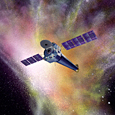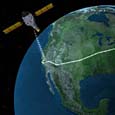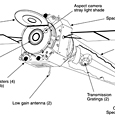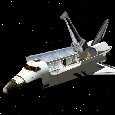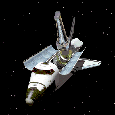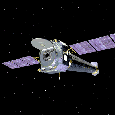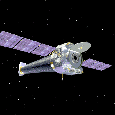CXC Home | Search | Help | Image Use Policy | Latest Images | Privacy | Accessibility | Glossary | Q&A
2. Chandra X-ray Observatory Spacecraft
This artist's illustration depicts NASA's Chandra X-ray Observatory in space.
(Illustration: NGST)
This artist's illustration depicts NASA's Chandra X-ray Observatory in space.
(Illustration: NGST)
Download:
2a. Chandra X-ray Observatory Spacecraft
This artist's illustration depicts NASA's Chandra X-ray Observatory with no background imagery.
(Illustration: NGST)
This artist's illustration depicts NASA's Chandra X-ray Observatory with no background imagery.
(Illustration: NGST)
Download:
3. Chandra Beauty Shot
These high definition artist's conceptions show a few different views of the Chandra X-ray Observatory. Chandra, one of NASA's "Great Observatories," has been operating in space since 1999. Chandra detects and images X-ray sources that lie within our Solar System to those billions of light years away. The results from Chandra help explore high-energy phenomena and provide insights into the Universe's structure and evolution.
(Illustration: NASA/CXC/D.Berry)
View the animation
These high definition artist's conceptions show a few different views of the Chandra X-ray Observatory. Chandra, one of NASA's "Great Observatories," has been operating in space since 1999. Chandra detects and images X-ray sources that lie within our Solar System to those billions of light years away. The results from Chandra help explore high-energy phenomena and provide insights into the Universe's structure and evolution.
(Illustration: NASA/CXC/D.Berry)
View the animation
Download:
5. Chandra Illustration with Earth
An artist's illustration of the Chandra spacecraft orbiting Earth. Chandra's orbit, which has the shape of an ellipse, takes the spacecraft more than a third of the way to the moon before returning to its closest approach to the Earth of 16,000 kilometers (9,942 miles). The time to complete an orbit is 64 hours and 18 minutes.
(Illustration: NASA/CXC/D.Berry & M.Weiss)
An artist's illustration of the Chandra spacecraft orbiting Earth. Chandra's orbit, which has the shape of an ellipse, takes the spacecraft more than a third of the way to the moon before returning to its closest approach to the Earth of 16,000 kilometers (9,942 miles). The time to complete an orbit is 64 hours and 18 minutes.
(Illustration: NASA/CXC/D.Berry & M.Weiss)
Download:
6. Chandra Spacecraft
An artist's illustration of the Chandra spacecraft.
(Illustration: NASA/CXC/NGST)
An artist's illustration of the Chandra spacecraft.
(Illustration: NASA/CXC/NGST)
7. Spacecraft in Orbit
An artist's illustration of the Chandra spacecraft in orbit.
(Illustration: MSFC)
An artist's illustration of the Chandra spacecraft in orbit.
(Illustration: MSFC)
Download:
8. Data Path
Communication between the Chandra Observatory and the Chandra operations and control facility is via the deep space network. View the animation.
(Illustration: CXC/D.Berry)
Communication between the Chandra Observatory and the Chandra operations and control facility is via the deep space network. View the animation.
(Illustration: CXC/D.Berry)
Download:
9. Chandra and the Deep Space Network
Data from Chandra are transmitted via the Deep Space Network stations to the Jet Propulsion Laboratory and from there to the Chandra Operations Control Center in Cambridge, MA.
Please note: In this illustration, Chandra's solar panels are positioned incorrectly to show entire working surface. Correctly positioned, the solar panels always face the Sun. Chandra's mirror aperture always faces away from the Sun (see image 2). (Illustration: CXC)
Data from Chandra are transmitted via the Deep Space Network stations to the Jet Propulsion Laboratory and from there to the Chandra Operations Control Center in Cambridge, MA.
Please note: In this illustration, Chandra's solar panels are positioned incorrectly to show entire working surface. Correctly positioned, the solar panels always face the Sun. Chandra's mirror aperture always faces away from the Sun (see image 2). (Illustration: CXC)
Download:
10. Map of Deep Space Network
Map of the Deep Space Network, showing locations of radio transceivers in California, Spain, and Australia.
(Illustration: CXC)
Map of the Deep Space Network, showing locations of radio transceivers in California, Spain, and Australia.
(Illustration: CXC)
Download:
11. Sketches
View labeled & unlabeled sketches of the CXO. See a detailed schematic fact sheet.
(Sketches: NASA/CXC/NGST)
View labeled & unlabeled sketches of the CXO. See a detailed schematic fact sheet.
(Sketches: NASA/CXC/NGST)
Download:















